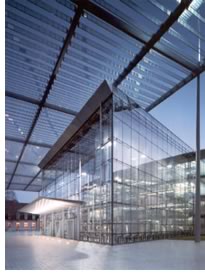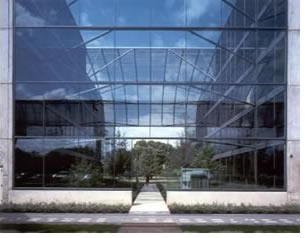

Friday’s General
Session Marks Celebrations, Both Somber and Joyous
Chicago’s Helmut Jahn, FAIA, proves
God still is in the details
Friday, June 11, the midpoint of the 2004 AIA National Convention’s “Learn Celebrate Dream” theme offered AIA members much reason to “Celebrate” both happy and sad events touching the profession, the nation, and, indeed, the world.
Tributes
Noting the national day of mourning for President Ronald Reagan, AIA President
Eugene C. Hopkins, FAIA, presented to the audience a videotape that President
Ronald Reagan had made for the AIA 1987 Grassroots Leadership Conference
in Washington, D.C. Welcoming the attendees to the nation’s capital,
Reagan had expressed the joy he felt at living and working in an “architectural
treasure. I never cease to feel the power of architecture to bring delight
to our lives,” he said. “Architect is a mirror for who and
what we are.” Reagan referred to architects as “designers
of the American dream,” saying “you have served the public
interest with distinction. It’s a public trust that cannot be taken
lightly, and I wish you every success.” Hopkins then called for
a moment of silence in memory of the late president.
The audience also paused for a moment to pay tribute to the late Samuel Mockbee, FAIA, the 2004 AIA Gold Medal recipient. Hopkins presented a video tribute to Mockbee from this year’s Grassroots conference, which showed Mockbee’s wife Jackie and son Julius receiving the medal. “Nothing would have given me more pleasure than to present the award to the man himself, surrounded by his friends and family,” Hopkins said.
A challenge for sustainability
The Hon. Jeremy Harris, mayor of Honolulu and the AIA’s new public
director on the national board, spoke of the problems facing our cities
today. He said that he believes that our planet is on the brink of possible
catastrophic climatic change, and that our salvation will be a shift from
the “paradigm of consumption and waste,” caused by unsustainable
development. “Our future is going to be determined by the fate of
our cities,” Harris declared. “The only way to reverse the
trend is to build sustainable cities.”
Sustainability is all about design, Harris continued, and the United States has lagged behind in promoting sustainability as a public policy. He challenged the AIA to champion this vital cause and bring members’ expertise to mayors and cities across the country. “It’s all about design,” he said. “AIA: America needs you! Step forward to the challenge!”
Celebrations
Hopkins then bestowed a presidential citation upon the Chicago
Tribune architecture critic Blair Kamin in appreciation of “the
rhapsodies and the scoldings” that have brought architecture to
the attention of Chicago’s public.
“This is an honor for me and for Chicago,” Kamin responded. He explained that his most important function is to raise sights and minds onto the importance of architecture in our lives. He accepted the citation on behalf of Chicago’s architects and all the others “who have turned construction into art” to create Chicago’s exciting architectural revival.
Also in keeping with the theme of “Celebrations,” Hopkins presented AIA Executive Vice President/CEO Norman L. Koonce, FAIA, and his wife Sue a special citation on the occasion of their 50th wedding anniversary, with much affection from their many friends at the AIA.
 Jahn:
A totally integrated approach
Jahn:
A totally integrated approach
As a representative of McGraw-Hill Construction, Architectural
Record Editor Robert A. Ivy, FAIA, had the privilege of introducing
Friday’s keynote speaker, renowned architect Helmut Jahn, FAIA,
noting Jahn’s career-long pursuit of intelligent architecture. “I
am fortunate to address this group in Chicago,” the Germany-born
Jahn said. “It has become my home.”
Jahn explained that since the 1990s, he and his colleagues have fine-tuned an abiding interest in the integration of technology into design. He calls this parti a “totally integrated approach,” or “archineering,” and says that it encompasses new technologies to sustain resources in buildings and an emphasis on human comfort. As early as 1989, Jahn put forth the premise that buildings built after 2000 could not be built of brick and steel, but rather needed to have changeable skins that would adapt to environmental conditions, in much the same way that humans adapt by adding and removing layers of clothing. Achieving adaptable architecture “is possible through the change in the relationship between architecture and engineering,” he explained. “This will lead us to a new architecture.”
Jahn presented a series of his works over the past 15 years that demonstrate the progression in the development of this integrated theory. First was Chicago’s State Street Village, Illinois Institute of Technology, which works as a defining wall while at the same time being “pervious” to allow movement through the campus to the elevated train on the opposite end. Between the three U-shaped buildings forming entry courts are two “sally-ports,” and, towards the elevated train, large glass screens protect the interior from external noise. The project, which captured a 2004 AIA Honor Award for Architecture, has walls that become transparent and opaque in response to environmental changes.
 Among
Jahn’s vast body of work that encompasses his firm’s “new
technological vision and order” is the Sony Center Complex, a reconstruction
of a central part of Berlin, begun in 1991 and completed in 2002. The
complex encompasses attractive residential and commercial structures by
other architects, notably Renzo Piano, and has at its heart the Sony Headquarters
Building by Murphy/Jahn. It shows, Jahn says, that “architecture
can be developed as a city.”
Among
Jahn’s vast body of work that encompasses his firm’s “new
technological vision and order” is the Sony Center Complex, a reconstruction
of a central part of Berlin, begun in 1991 and completed in 2002. The
complex encompasses attractive residential and commercial structures by
other architects, notably Renzo Piano, and has at its heart the Sony Headquarters
Building by Murphy/Jahn. It shows, Jahn says, that “architecture
can be developed as a city.”
The complex’s vast constructs of glass with minimal connectors emphasize transparency and light, enhanced with the lighting designs of Yann Kersale. Its elliptical umbrella roof provides providing shading and protection from the elements. The essence of the design, the architect has said, is combining natural and artificial light with the building's transparency, permeability to light, reflection, and refraction. The Sony Building received a 2002 Honor Award for Architecture.
Jahn also presented two 2004 AIA Honor Award-winning buildings, the Bayer building in Leverkusen, Germany, and the Deutsche Post in Bonn, in which, he says, “the architect and the engineer speak the same language more that ever. All is engineered, not designed. I think this is where true progress will live,” he concluded. “We need to promote buildings that enhance the lives of people who use them.”
Copyright 2004 The American Institute of Architects.
All rights reserved. Home Page ![]()
![]()
 |
||
|
|
||